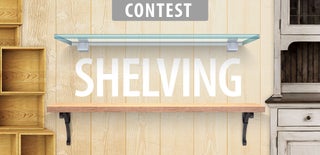Introduction: Garage Shelves
This is an easy and affordable method I've used to build all my garage shelves. They are extremely strong and will support anything I put up there.
In this instructable I’ll walk you through a step-by-step process of how to build shelves with a little bit of engineering insight to add to your understanding of building strong structures.
Step 1: Supplies, Tools, and Cost
Supplies & Cost
- 2x4x8 $2.79 ea. (9 used)
- 2x4x10 $4.30 ea. (2 used)
- OSB 4x8 (3/8 th.) $10 ea. (2 used)
- Screws (2.5 in.) $10
- Framing Angles $0.50 ea. (4 used)
- Joist Hangers $0.75 ea. (4 used)
Total: $68.71 + tax
Tools:
- Drill
- Level
- Framing Square
- Miter Saw
Time Needed:
The time to complete this project was about 2.5 hours, for the two of us, once we had all the materials needed.
Helpful Tip:
Most home improvement stores have a saw to cut down the OSB which eliminates the need for a table saw. I, almost always, have them cut it down for me.
Step 2: Marking Up the Walls
To make things easier I measured out lines for each and drew them on the wall using a level. This way all I needed to do was line the 2x4's up with the marks that were already made level. The only thing to really consider is the thickness of the 2x4 AND OSB that serves as the top surface of the shelf. Both of these need to be accounted for when spacing out the shelves.
Step 3: Cornered In
A square and level can be used to continue the line onto the adjacent wall.
Step 4: All Lined Up
As a result, you should end up with a wall full of level lines to guide the placement of each 2x4.
When securing the 2x4's up to the wall, be sure to pre-drill each hole with a bit that is slightly smaller in diameter than your screws. Doing this will help prevent the wood from splitting. I chose to place 2 screws in each stud (in the actual wall) to provide maximum support.
Note:
You can actually use 2x3's in this step to save approximately $0.80 per board.
Step 5: Building Each Shelf
Each piece of OSB was cut to 8ft x 20in
The 2x4's were cut down by about 3in to allow the top surface to overlap the boards already mounted on the walls. Therefore a 1.5in space should be made on each side of the shelf. Once aligned properly and flushed up to the edge the OSB was secured to the 2x4's using some wood screws.
Step 6: Hanging Shelves
Each shelf can the be place in position on the wall and supported on the loose end with a 2x4 acting as a pillar.
Clamp the shelf to the pillar and tack a few screws along the back of the shelf to safely secure it to the wall. Repeat this process for each shelf.
The reason for only using a clamp in this stage is to allow for leveling the shelves but also giving the freedom to plumb (vertically level) the supporting pillar.
Step 7: Tying It All Together
Once the pillar is plumb each shelf can be leveled across the top and screwed to the pillar. Also, I chose to give the added support of framing angles on the pillar side and joist hangers on the opposite end.
Doing this is probably overkill but it eliminates the possibility of splitting the wood (at the screws) due to excessive weight on the shelf and thereby maximizing the strength of the 2x4 beams. This is better explained in the nest step.
Step 8: A Bit of Engineering Flavor
To further explain the reasoning in the previous step you should realize the area moment of inertia (resistance to bending) of a rectangle beam is equal to (base x height^3)/12. This means the greatest single contributor to the strength of a beam is the height of the cross-sectional area, since it's to the 3rd power. This is why an I-beam is tall and skinny. Therefore, by supporting the 2x4 beam from underneath, the strength is significantly increased.
Step 9: End Supports
Finally, boards were cut to fit the loose end of each shelf. Doing this provides a little more stiffness across the midsection of the OSB.
Step 10: Enjoy!!
Now you have a very strong shelf to hold all your storage items. I've stood on these and bounced with little to no deflection in the 2x4 beams. Better yet, there are no pillars in the center obstructing the storage space.
Hopefully you were able to get something valuable out of this. If you liked it please vote for this project in the Shelving Contest.

Runner Up in the
Shelving Contest 2016













